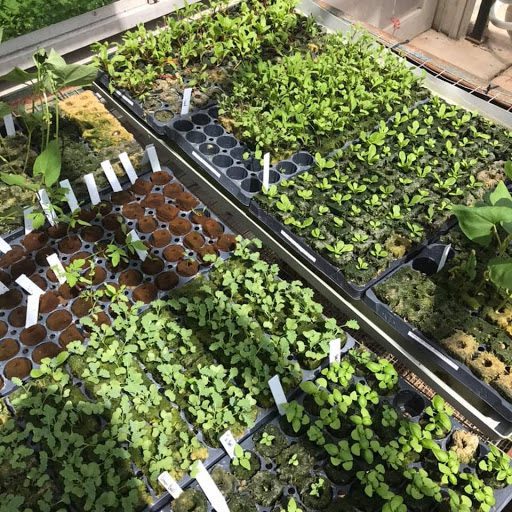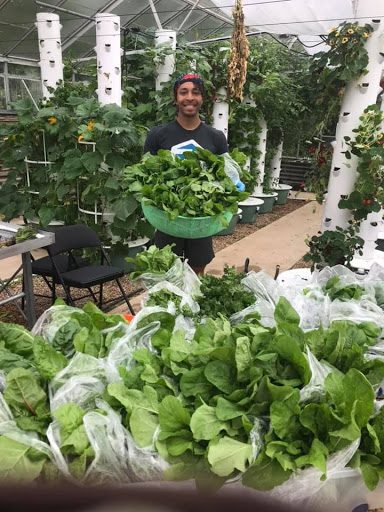A Texas A&M student-run farming organization has swapped out the shovels and soil for aeroponic towers. Rather than growing produce in the ground, the Texas A&M Urban Farm United (TUFU) is growing up. And the best part: the group is growing for good–not only to benefit the environment but also to feed the community.

TUFU utilizes an automated aeroponic tower system of vertical growth that requires up to 90 percent less land and 98 percent less water while producing 30 percent more yield, the group’s co-founder and director Lisette Templin confirmed during an interview with Garden & Health. In an aeroponic growing system, plant roots hang in the air and are nourished with nutrient-dense water.
Texas A&M student Stephon Warren, who is pursuing a master’s degree in plant breeding, is TUFU’s director of operations. During an interview with Garden & Health, he elaborated that the group’s towers utilize a timed drip irrigation system where water drips on the plant’s roots in a percolating manner. TUFU grows at a greenhouse on campus which features 24 towers capable of growing 150 different plant species.

The project was initiated last year by Templin, an instructional assistant professor from Texas A&M’s Department of Health and Kinesiology, and Department of Soil and Crop Sciences graduate Broch Saxton, who has since left the program. It was founded with the primary focus of combating food insecurity on campus by helping to supply the university’s 12th Can food pantry. According to Templin, the pantry feeds about 150 families every two weeks. Templin utilizes a tower at home to grow vegetables and wanted to share aeroponic farming with others.
“I started an aeroponic garden at home. I have a residential tower that I had been growing for six years to feed my family of five,” said Templin. “And, after six years I thought ‘oh my gosh–if only more people could know about this.’ I saw the Aggie Green Fund grants looking for sustainability methodology to help campus be more aware.”

Last August, the project was awarded a $60,000 grant from the Fund, and Texas A&M’s Department of Plant Pathology provided a greenhouse. The University’s School of Public Health handles the administrative work and the provost’s office connects capstone students with the program, which helps with labor. This joining of forces is why “United” is a part of the group’s name, Templin emphasized. The funding was primarily used to purchase the growing towers, for labor, seeds, and all of the tools that were needed to create the aeroponics system. TUFU’s first harvest was in December 2019.
Warren says he connected with the group during a tough time in his life and that growing produce for those in need has been personally uplifting.

“Being able to feed people is just outstanding. I can feed people and grow plants? Why not do something like that?” Warren said. Something that has surprised him is that, while there have been some agriculture student volunteers, the majority of those involved are students from other majors such as business and engineering.
According to Templin, between December 2019 and June 2020, the group has donated more than 1,000 heads of leafy greens, 40 pounds of tomatoes, and 30 pounds of cucumbers, among other vegetables and herbs to The 12th Can.

While the group has always focused on donations, Warren explains that it will shift toward selling to local restaurants as well at farmer’s markets to ensure longevity. Aided by a $4,200 grant from Texas A&M’s School of Innovation, the organization was able to launch TUFU Market which will serve as its platform for local sales. By selling produce from half of the 24 towers, the group hopes to self-fund its operations. TUFU Market was inspired by a similar initiative of Howdy Farm–another farming group on campus which sold at farmer’s markets, Warren said.
TUFU grows different types of lettuce, Thai and regular basil, peppers, tomatoes as well as seedlings including turnips, radishes, snap peas, and lima beans. The organization avoids using commercial pesticides and instead uses eco-friendly solutions including a garlic spray and other organic types, Templin said. Additionally, she said that the group plans on using its basil to make pesto. TUFU plans to sell the products at their ‘TUFU Market Day,’ the first of which will be held on Oct. 24 at Brazos Valley Farmers Market in Downtown Bryan, Texas.
The organization also acquired its first restaurant purchaser–Nam Café, which has a location near the main campus. The restaurant’s owner, Van Tran, told The Eagle that he is excited to be TUFU’s first partner and feels that using the locally grown ingredients will take his dishes to the next level.
“It was a no-brainer for me because, first, we would be able to get organic produce — lettuce and basil — but, secondly, also an opportunity to be a part of the community,” he told the publication.
Templin sees selling to restaurants as a way to showcase the potential for making urban farm-to-table operations more mainstream.
“We want to sell to local restaurants to prove to people that purchasing urban-local, green clean food is very, very possible,” she said. Lisette noted that just before our interview she dropped off 30 heads of lettuce–TUFU’s “first commercial batch.”
For both Templin and Warren, it is clear that they hope their urban farming project will be a catalyst for change and help encourage a larger-scale operation.
“Let me tell you, our way of life has to change,” said Templin, who explains that increased imports and pesticide use have reduced the overall quality of our food. “My personal vision and I believe Stephon’s also, is to have a very large greenhouse on Texas A&M’s campus.” Templin says that despite being a campus of 70,000 students, the idea of at least supplying specific foods to cafeterias is totally doable.
“I just want to see a greenhouse for us that we can grow food to feed the students on campus and continue to feed the surrounding community because there are large portions of College Station and Bryan, which is the area surrounding College Station, that is food insecure,” said Warren. “So, to show people that you can grow this in your own backyard…feed yourself, I just don’t see why we haven’t been doing it already.”





